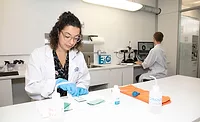Researchers Create Nanoscale Gold Coating With Largest-Ever Superlattice
TROY, NY - Researchers at Rensselaer Polytechnic Institute developed a new method for creating a layer of gold nanoparticles that measures only billionths of a meter thick. These self-assembling gold coatings with features measuring less than 10 nanometers could hold important implications for nanoelectronics manufacturing.
In addition, Sang-Kee Eah, assistant professor in the Department of Physics, Applied Physics, and Astronomy at Rensselaer, demonstrated how the gold nanoparticles assemble into a unique uniform pattern called a superlattice. Eah observed a superlattice measuring 20 microns, with a distance between lines of nanoparticles - or lattice constant - of 8.8 nanometers. He said the 20-micron superlattice domain is the largest ever documented, and this new technique could lead to even larger superlattices with even tinier features.
“Thinking about semiconductors, this discovery could offer new solutions for scaling down the features of today’s most advanced 32-nanometer computer chips to have features in the range of less than 20 nanometers, or even less than 10 nanometers,” Eah said. He used scanning electron microscopy, with Moire interference patterns, to measure the boundaries of the superlattice.
Results of the study, titled “A very large two-dimensional superlattice domain of monodisperse gold nanoparticles by self-assembly,” were recently published in the Journal of Materials Chemistry. The paper may be viewed online at http://dx.doi.org/10.1039/C1JM11671A.
To create the nanolayer, Eah infused liquid toluene - a common industrial solvent - with gold nanoparticles. The nanoparticles form a flat, closely packed monolayer of gold on the surface of the liquid where it meets air. By moving the nanolayer of gold nanoparticles to another air-water surface, the large superlattice was formed and coated onto a silicon wafer after the toluene and water evaporated.
In addition, Sang-Kee Eah, assistant professor in the Department of Physics, Applied Physics, and Astronomy at Rensselaer, demonstrated how the gold nanoparticles assemble into a unique uniform pattern called a superlattice. Eah observed a superlattice measuring 20 microns, with a distance between lines of nanoparticles - or lattice constant - of 8.8 nanometers. He said the 20-micron superlattice domain is the largest ever documented, and this new technique could lead to even larger superlattices with even tinier features.
“Thinking about semiconductors, this discovery could offer new solutions for scaling down the features of today’s most advanced 32-nanometer computer chips to have features in the range of less than 20 nanometers, or even less than 10 nanometers,” Eah said. He used scanning electron microscopy, with Moire interference patterns, to measure the boundaries of the superlattice.
Results of the study, titled “A very large two-dimensional superlattice domain of monodisperse gold nanoparticles by self-assembly,” were recently published in the Journal of Materials Chemistry. The paper may be viewed online at http://dx.doi.org/10.1039/C1JM11671A.
To create the nanolayer, Eah infused liquid toluene - a common industrial solvent - with gold nanoparticles. The nanoparticles form a flat, closely packed monolayer of gold on the surface of the liquid where it meets air. By moving the nanolayer of gold nanoparticles to another air-water surface, the large superlattice was formed and coated onto a silicon wafer after the toluene and water evaporated.
Looking for a reprint of this article?
From high-res PDFs to custom plaques, order your copy today!







